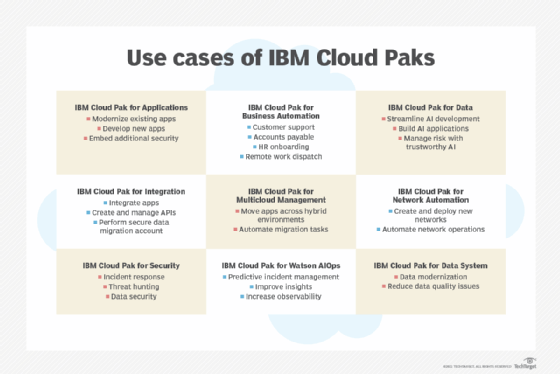
Getty Images/iStockphoto
Examine IBM's hybrid cloud strategy
IBM's focus on hybrid cloud efforts, including Cloud Paks and OpenShift, makes for a competitive option. See if its strategy fits your enterprise needs.
Both hybrid and multi-cloud have been hot topics for enterprises and providers. AWS, Microsoft Azure and Google Cloud are working on different hybrid efforts to attract customers, as is IBM.
IBM has rolled out a companywide focus on hybrid cloud including on its Red Hat OpenShift assets. Find out what IBM is doing and why it matters.
The challenge of application portability
In a hybrid environment, applications run on multiple sets of resources, i.e., on infrastructure in data centers and cloud providers. Many of these application components map statically to only one set of resources. However, many also involve scaling or failover across resource boundaries. For hybrid and multi-cloud users, this heterogeneity of resources can complicate operations, as well as increase potential for errors and costs.
Containers encapsulate the data and dependencies so that each element can deploy, redeploy and scale, decoupling the application component from the hosting resources. Kubernetes, the most popular container orchestration tool, adds the operational automation to make containers an efficient way to run an application, even if the application spans multiple clouds and data centers. However, if a containerized component uses a cloud-specific service with an API from that cloud provider, it's no longer portable to another cloud or to data center resources.
The alternative to these APIs from cloud services, such as managed container services or Kubernetes, is a portable cloud application suite, installed on all the resources where the hybrid or multi-cloud application will run. Because cloud services are based on VMs or generic containers, everything is portable. Better yet, if a cloud provider supports a suite, then that support readies the cloud for open scaling and failover too. IBM is pursuing this strategy for heterogeneous hosting.
IBM's hybrid approach
The foundation of IBM's hybrid cloud approach is a collection of software that creates a highly portable PaaS. This replaces cloud-specific features and APIs to run applications. Its base is Red Hat OpenShift Enterprise Linux and Kubernetes. A set of cloud deployment and management tools are portable across clouds, as well as in the data center.
On top of OpenShift, IBM layers in its Cloud Pak hybrid cloud software. Cloud Paks is a software that is preintegrated and containerized. Built on RedHat OpenShift, Cloud Paks can be used anywhere and from any cloud. At its core, Cloud Paks is designed to develop cloud services such as data, automation and integrations. It is a major component of IBM's hybrid strategy. This sets it apart from Microsoft's Azure cloud.

OpenShift is a complete container hosting and deployment approach. It overlays customized automated operations, cluster services, application services -- including service mesh -- and developer services onto Red Hat Enterprise Linux and Kubernetes. The goal is to create a container environment that's easier to use than one built up from scratch. The result is roughly equivalent to a cloud provider's container or Kubernetes service.
Red Hat offers a managed version of OpenShift that is available on Microsoft Azure, AWS, IBM Cloud and Google Cloud. OpenShift's dependence on other Red Hat elements -- RHEL in particular-- may create issues for users who prefer a different Linux distribution. OpenShift doesn't include features for IoT, AI or functional computing, while other major cloud services platforms do.
The modular nature of the Cloud Paks mirrors the way cloud providers group their own web services. Red Hat elements can be used to provide some of the more application-specific elements of cloud applications, including IoT. Both IBM and Red Hat's development tools can be used to build applications and to integrate between the cloud(s) and the data center. The combination of the data center components from both IBM and Red Hat, and the hybrid integration skills of both organizations, are the assets that make the IBM hybrid and multi-cloud strategy stand out against its competitors.
Who should choose IBM?
IBM's offering is uniquely suited for its mainframe installed base. Despite the widespread view that mainframes are legacy hardware, they process billions of transactions each year. Mainframes are still the mainstay of many corporate data centers. Enterprises with a significant IBM mainframe investment and that plan to build or expand hybrid or multi-cloud deployments will find the IBM solution tuned to their needs.
Similarly, Red Hat customers who use OpenShift in their data centers can expect an easy evolutionary path to hybrid or multi-cloud through IBM's approach. For those hybrid or multi-cloud adopters who want to scale and failover across cloud and data center boundaries, IBM's OpenShift foundation is a strong candidate. Cloud Paks extend that basic platform. IBM also offers a cloud developer program, as well as financing and other tools for its customers.
IBM has its own cloud, and it also emphasizes its own AI assets, weaving AI through its hybrid story. However, IBM's "portable" approach has less value for enterprises that don't expect to move components between clouds and data centers.
IBM's greatest strength isn't the features of its hybrid cloud strategy, but its integration and completeness. The company magnified that benefit with the acquisition of Neudesic, a cloud consultancy, in 2022.







